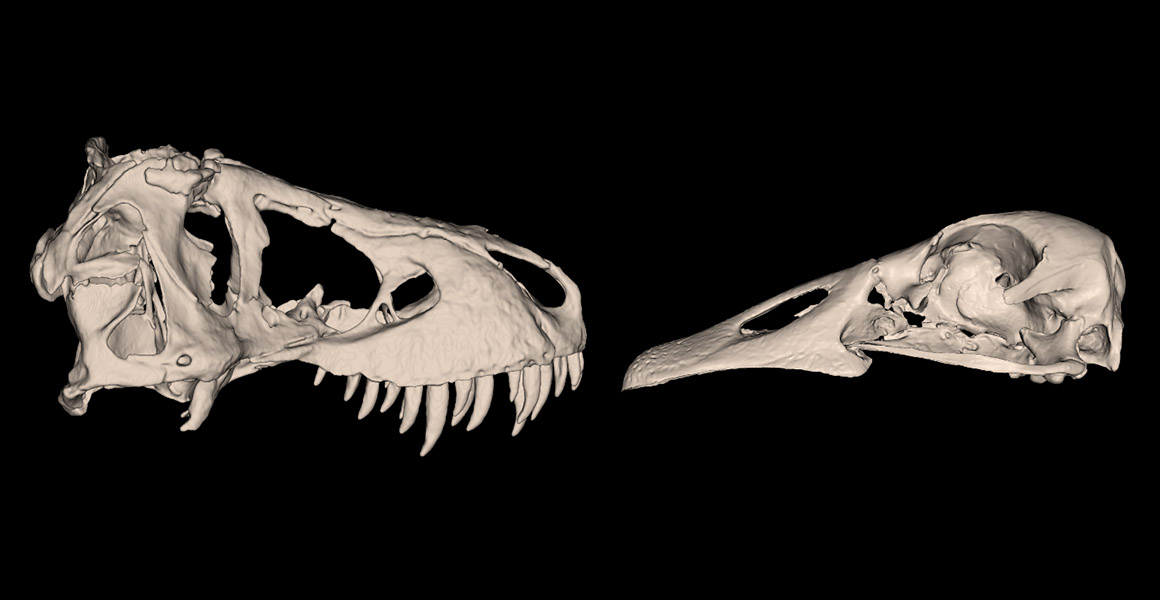A team of scientists at the Natural History Museum, led by Dr. Ryan Felice, scientific associate, and Prof. Anjali Goswami, research leader, has revealed that the great diversity found in birds’ skulls today actually represents a huge bottleneck and evolutionary slowdown compared to other dinosaurs.

3D scans of bird and dinosaur skulls used in the study © R. Felice
We think of birds as being incredibly diverse, with huge variation seen from hawks to hummingbirds and pigeons to pelicans. Although the earliest birds evolved 150 million years ago in the Jurassic previous studies have shown that their modern diversity evolved in a burst of evolution after the other dinosaurs died out in the end-Cretaceous mass extinction.However, it turns out that bird diversity is only the tip of the iceberg of broader variation in dinosaurs, the precursor to modern birds.
To understand the variation in bird and dinosaur skulls and how these changes occurred, the team studied their skull morphology.They used high resolution 3D scanning to explore how the bird skull fits into the big picture of dinosaur skull evolution.
The skulls of over 390 species of birds and non-avian dinosaurs were 3D surface and CT scanned to create the biggest dataset of bird and dinosaur skulls to date and included many beloved specimens, such as Dippy and Sophie. Then using state-of-the-art methods, studies were carried out to identify hundreds of 3D points of comparison across all these species. This made it possible to reconstruct the evolution of their skulls over more than 200 million years.No study to date has ever captured such a huge range of dinosaur diversity in such detail or directly compared the shape of the skull across the full range of living and extinct dinosaurs.
On collating their results, the team were surprised to find that the skull evolves much slower in birds than in non-avian dinosaurs.
Ryan Felice explains, ‘One of the biggest differences between birds and non-avian dinosaurs is the top of the skull or braincase. This part of the skull evolves into lots of different forms across non–avian dinosaur species and at very fast rates. The same part of the skull, however, is constrained in birds.’
‘This seems to be because dinosaurs have lots of variation in this region, associated with cranial ornaments, such as in the Triceratops.In contrast very few birds have bony ornaments like horns and crests on the skull.’
In birds most of the skull is taken up by large eyes and brains, rather than large biting muscles or ornaments. As a result, bird skulls are variable in the beak but not in the top or back of the skull.Birds elaborate their heads with feathers instead of bony elements.
Prof Goswami added, ‘By being able to directly compare birds with other dinosaurs, we can see that there wasn’t an explosion of bird skull shape after dinosaurs went extinct.Rather, skull evolution seemed to hit the brake pedal when birds evolved, with much, much slower evolution in birds than in other kinds of dinosaurs.Birds are the only dinosaurs alive today, but they are nowhere near as diverse or fast evolving as other dinosaurs were before the mass extinction. Dinosaurs evolved much faster before they became birds.’
‘In fact, some of the specialized features of birds, like their big brains and eyes, might limit how their skulls evolve and be the main reason they can’t evolve as much variation as their extinct relatives.’
This project is part of a larger study of skull evolution across all vertebrates, led by NHM Research Leader Prof. Anjali Goswami. The ambitious plan is to try to capture the shape of life on the planet and to understand how factors like life cycles, ecology, habitat, and extinction drove diversity of species in the past and continues to drive it now and in the future.
In recent years, the team have published studies using this innovative approach in birds, snakes, lizards, frogs, salamanders, and caecilian amphibians, with studies of crocodiles, turtles, and mammals coming soon.
All the 3D scans are available for free online via the NHM’s Phenome10K.org database, making it possible for anyone to download them.
The study Decelerated dinosaur skull evolution with the origin of birds is published in the journal PLoSBiology on Tuesday, August 18.
Notes to editors
Images available to download here.
The Natural History Museum exists to inspire a love of the natural world and unlock answers to the big issues facing humanity and the planet. It is a world-leading science research centre, and through its unique collection and unrivalled expertise it is tackling issues such as food security, eradicating diseases and managing resource scarcity.
The Natural History Museum is the most visited natural history museum in Europe and the top science attraction in the UK; we welcome around five million visitors each year and our website receives over 850,000 unique visitors a month. People come from around the world to enjoy our galleries and events and engage both in-person and online with our science and educational activities through innovative programmes and citizen science projects.
Contact Us
Weekdays: +44 (0)20 7942 5654
Evenings and weekends:
+44 (0) 7799 690 151
Email: press@nhm.ac.uk
Don't miss a thing
Receive email updates about our news, science, exhibitions, events, products, services and fundraising activities. We may occasionally include third-party content from our corporate partners and other museums. We will not share your personal details with these third parties. You must be over the age of 13. Privacy notice.
Follow us on social media